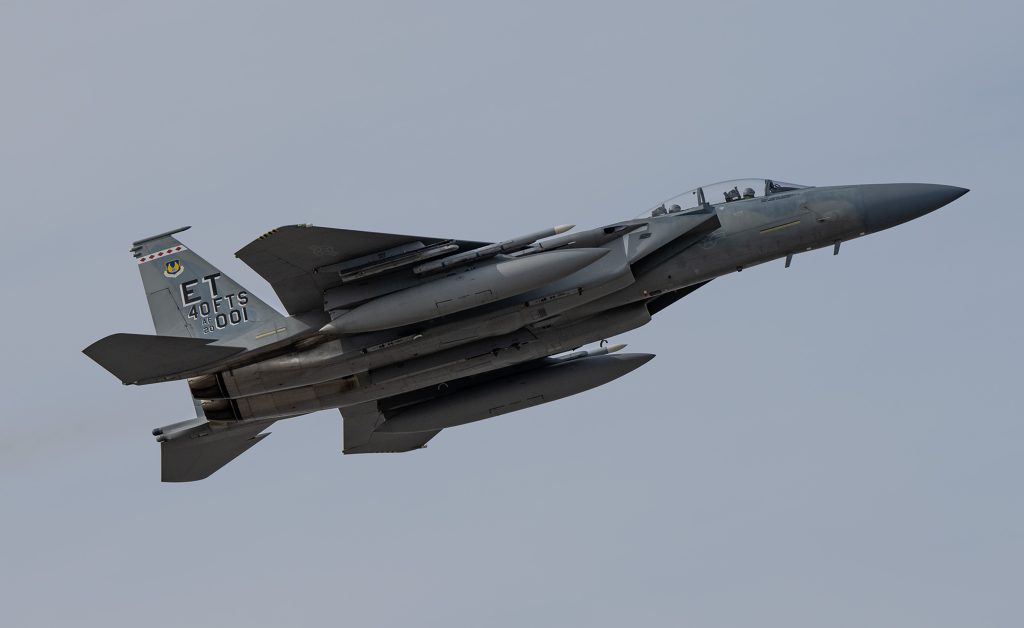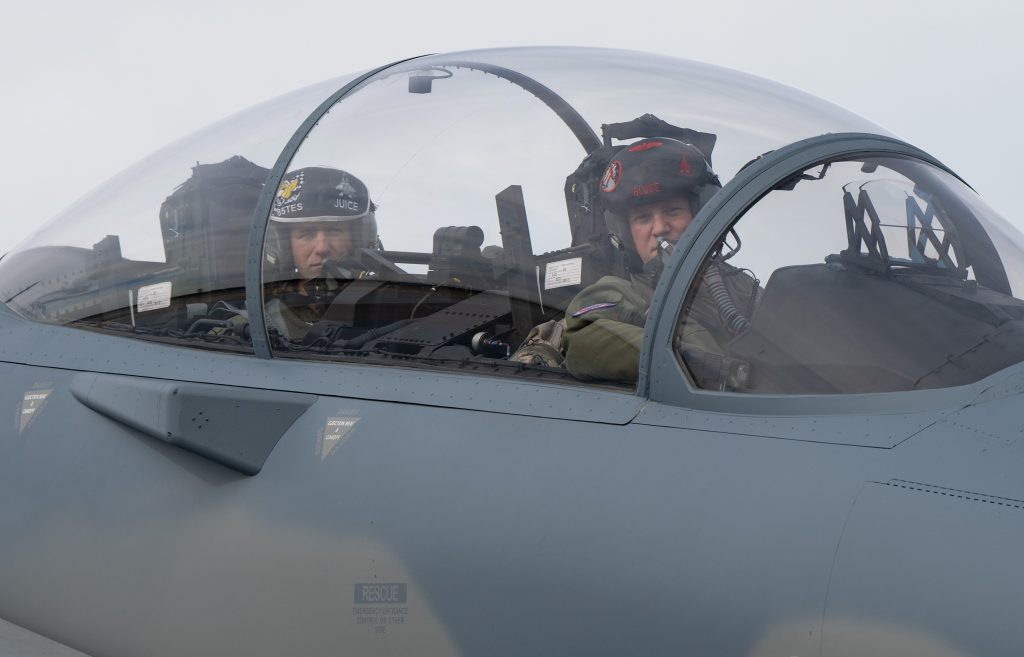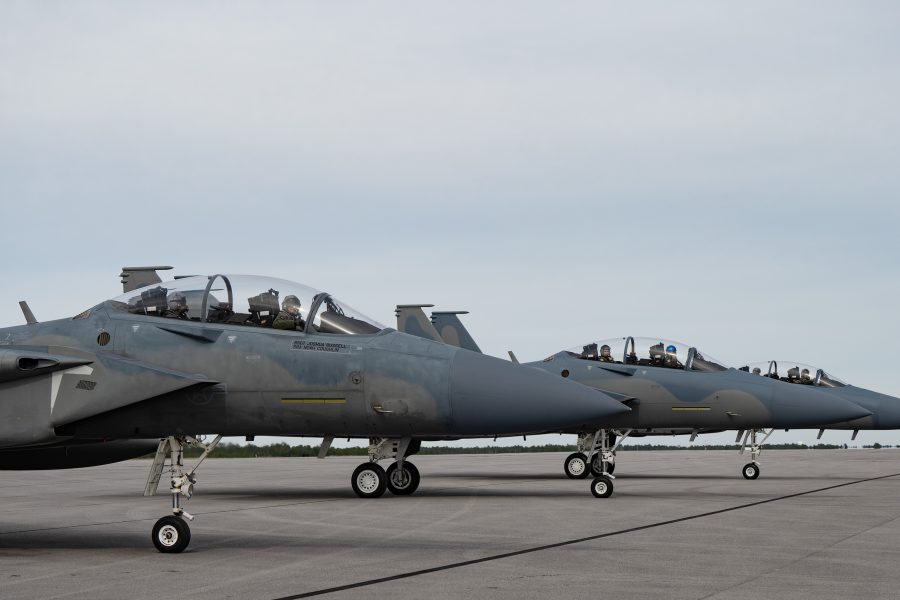The third and fourth airframes of the Boeing F-15EX Eagle II have arrived at Eglin Air Force Base, Fla., for testing, the Air Force said Dec. 30. To hold the program schedule, six more need to be delivered before July.
The new aircraft, dubbed EX3 and EX4, arrived at Eglin on Dec. 20, the Air Force said. EX1, EX2, and EX4 belong to the 53rd Wing, while EX3 belongs to the 96th Test Wing.
The aircraft are undergoing both developmental and operational testing simultaneously, in order to compress the test schedule and get operational aircraft to the fleet as soon as possible. The first EX was delivered to Eglin in 2021. Flight test data acquired from similar aircraft sold under the Foreign Military Sales program has also been incorporated into the combined test effort.
The two new jets will also be earmarked for flight test, as will the next two. The last pair delivered under the first lot will be operational aircraft assigned to the Oregon Air National Guard, which runs the Air Force’s F-15 schoolhouse.

Aircraft Nos. 3 and 4 are about a year late, a situation Boeing has chalked up to supply line problems, manufacturing mistakes, and delays stemming from shifting some production work from South Korea to the U.S. The last four aircraft of the first lot are expected to be delivered by the spring.
According to the best-case, or “objective,” scenario under the F-15EX contract, the program was supposed to achieve initial operational capability (IOC) by last July, but did not do so. It can still meet the “threshold” or minimum-required IOC deadline of July 2024 if the Air Force takes delivery of eight total aircraft by then. If it doesn’t, the program will be in breach of the Nunn-McCurdy Act, requiring certifications from the Secretary of Defense to continue.
Full operational capability is deemed to be 44 jets on duty, with all the necessary pilots, spares, and support gear. It is now expected in 2027.
In October, the Pentagon reported that the F-15EX will have a flyaway cost of $94 million per fighter, assuming the Air Force buys the planned 104 aircraft. That disclosure came after the service transitioned the EX from being a mid-tier acquisition program to a Major Defense Program, triggering a requirement to set baseline program costs in the quarterly Selected Acquisition Reports. The Air Force has considered F-15EX production as high as 188-200 airplanes, but seems to have settled on a force of 104 jets.
The $94 million price quoted by the service includes the Eagle Passive/Active Warning Survivability System (EPAWSS) jamming and electronic warfare suite for the new-build jets. The initial unit cost estimate for the Eagle II was $80 million, comparable to the flyaway cost of the F-35.
In 2018, the Pentagon directed the Air Force to buy the F-15EX, deeming it the quickest way to replace worn-out F-15Cs with fresh iron. Most of the F-15C fleet is beyond its planned service life—with an average age of 38 years—and suffers from severe structural fatigue issues, deteriorating wiring, and parts obsolescence, resulting in speed, load, and maneuvering restrictions. The oldest USAF F-15C has been in service since 1979.
The EX—based on the F-15QA developed for Qatar—is a fly-by-wire aircraft with a powerful new processor and an additional two weapon stations versus the F-15E Strike Eagle, giving the Eagle II the largest combat load in the Air Force’s fighter inventory.
Like the E model, the EX has accommodation for two seats, but the Air Force plans to operate the fighter with a single pilot. The EX is also supposed to be equipped with conformal fuel tanks (CFTs), like the F-15E. The CFTs also have weapon stations, and besides extending range, offer more air-to-ground weapon hardpoints. However, the service did not fund the CFTs for the first 50 or so EX models, meaning they will be optimized for air-to-air missions. Service officials have said the first squadrons will likely be assigned to handle the homeland defense mission, rather than ground attack.
The first two F-15EXs have participated in a number of exercises; notably Northern Edge 2023 in May 2023, and Combat Hammer in August, where they fired live rounds in weapons tests.
Unlike the initial two jets, the new aircraft have cockpit pressure monitors and a warning system, along with a high frequency antenna for satellite communications. They also “feature a forward fuselage redesigned specifically for the U.S. Air Force,” a service release said.
The Air Force said the 2023 annual report from the Pentagon’s director of operational test “stated that the F-15EX is operationally effective, suitable, and survivable against threats likely to be encountered while performing its missions in threat environments.” It added that this report “allows the program to move into a new testing phase.”
The F-15EX has “met every challenge we’ve thrown at it,” and is “on the cusp of being ready for the warfighter,” according to Lt. Col. Christopher Wee, Operational Flight Program Combined Test Force commander.
The new deliveries pave the way “for not only the delivery of combat-coded aircraft to the U.S. Air Force, but also the continued development” of the aircraft, he said.

The Air Force plans to buy 24 F-15EX in fiscal year 2025. Negotiations between Boeing and the Air Force on prices for production lots 2-4 were underway in the fall. The company has considered production rates between 24 and 48 aircraft per year at its St. Louis, Mo., facilities, and is marketing the EX to other countries with the Air Force’s blessing. Boeing has identified Indonesia as a possible EX customer, with an interest in buying 24 of the fighters.
Besides offering an in-kind replacement for the F-15C/D and E—performing both air superiority and ground attack missions after enemy air defenses have been beaten down—the EX is expected to serve as a standoff platform for launching long-range missiles and hypersonic weapons.
